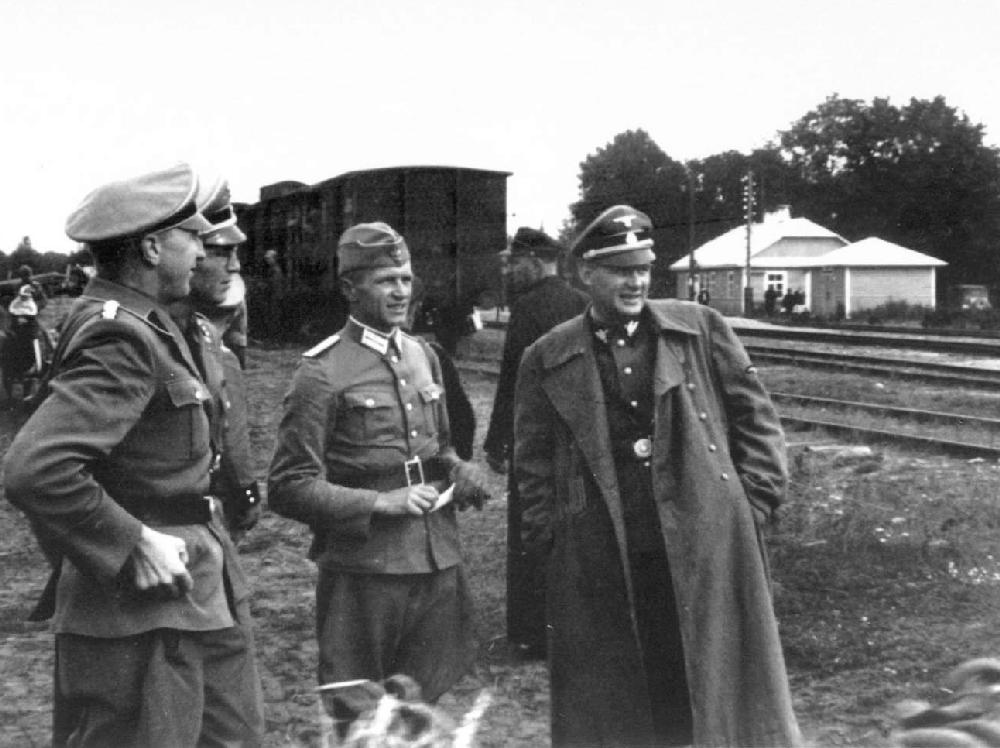
Individual NAZI Death Camps: Sobibor (Poland/Soviet Union/Belarus: May-June 1942, October-December 1942, and March-August 1943)

Figure 1.-- Odilo Globocnik was a failed Austrian NAZI and later a SS Gruppenführer. The unidentified men with him may include both SS and Wehrmacht men. The men behind them are raikway workers. They are at the railway lines leading into the Sobibor Camp. They are apparently just outside the Camp as we do not seet the unloading platforms. The boxcar looks like the standard railcar used to trabsport Jewish victims. Among the NAZI war criminals, Globocnik has a position as one of the most evil of the NAZI war criminals. He conbined killing Jews as an engine for personal enruchment. Himmler appointed Globočnik SS and Police Leader in the Lublin district of the General Government, meaning occupied Poland nox annexed to the Rich (November 1939). Himmler wanted to put Generalplan Ost in operation and Globocnik began doing just that. He had to stop, however, because it ws disrupting the war effort. As an associate of SS-Obersturmbannführer Adolf Eichmann, he had a leading role in Operation Reinhard, which involved the murder of over one million mostly Polish Jews in the newly opened death camps including Sobibor. Images from the death camps are rare, from Sobibor they are almost nonexistent. After running into trouble with Himmler for stealing some of the looted property of his victims, he surfaced in Italy where he set up a small operation in a rice mill where thousands of Italian Jews, partisans and other political dissidents were robbed, interrogated, tortured and murdered. He committed suiside after being capturd by the British (May 31, 1945).
|
|
Sobibor was the most isolated of the three Reinhard death/extermination camps. It was located in a lightly populsted area near Poland's current border with Belarus, fairly close to Belzec. It was established (March 1942), close to the village and rail station of Sobibor just off the Chelm-Wlodawa rail line. The camp itself was situsated in an isolated, wooded and swampy area. SS-Obersturmführer Richard Thomalla, a staff member of the SS Construction Office in Lublin, oversaw the construction. After only a month, SS-Obersturmführer Stangl replaced him. He completed the construction and became the first Camp Commandant. Stangl proved to be Odilo Globocnik's favorite and most trusted camp commander. The camp had about 15 German SS men who ran the camp, supervising about 150 Ukranian guards. As in all the death camps, Jews were forced to participate in the killing by the SS. There were also a number of Jews and Soviet POWs who served as prisoner workers. Sobibor despite its lethality, was very small. It was a rectangle, 400 by 600 meters. There was a 3m high barbed wire fence around it. The SS had tree branches worked into the wire so as the prevent outsiders from viewing what went on inside. It was divided into three separate areas: 1) administration, 2) reception, and 3) killing. Each of the different sectioins were separated by more barbed wire. The vast majority of those sent to Sorbibor to be killed were Jews. Most were murdered by gas within hours of their arrival. About 0.25 million Jews were killed at Sorbior, many from the surrounding area. Some Dutch Jews were also killed at the camp. There was no significant forced labor work at Sobibor. The sole purpose was to kill Jews as soon as they arrived. A few healthy Jews were selected for slave labor at nearby camps. Almost all of our accounts from Sorbibor comes from those selected for labor. The worker Jews and Soviet POWs staged a rare sucessful rising (October 14, 1943). They managed to kill a few SS and Ukranian guards. A few of the prisoners managed to escape, most of those who broke out were tracked down and killed by the SS as were all prisoners who did not participate in the uprising. The camp was subsequently closed, in part because of the advancing Red Army and in part because the number of available Jews in NAZIs had already been significantly reduced by the Aktion Reinhard killings. Very few photographs were taken at Sobibor. A movie was made bout the revolt, Escape from Sobibor (1978). Although the film focuses on the revolt, the operation of the camp is explsined in some detail.
CIH

Navigate the CIH Holocaust Section:
[Return to Main individual NAZI death camp page]
[Return to Main NAZI death camp page]
[Return to Main NAZI concentration camp page]
[Return to Main Operation Heydrich page]
[Return to Main Holocaust page]
[Return to Main World War II page ]
[Main Holocaust page]
[Allies]
[Biographies]
[Children]
[Concentration camps]
[Countries]
[Decision]
[Denyers/Apologists]
[Displaced persons]
[Economics]
[Eisatzgruppen]
{German Jews]
[Ghettoes]
[Impact]
[Justice]
[Literature]
[Movies]
[NAZIs]
[Occupied Poland]
[Process]
[Propagada]
[Resistance]
[Restitution]
[Questions]
[SS]
[Special situations]
[Targets]
[Wansee Conference]
[World War II]
[Main mass killing pagel
Created: 1:44 AM 12/17/2017
Last updated: 1:44 AM 12/17/2017



